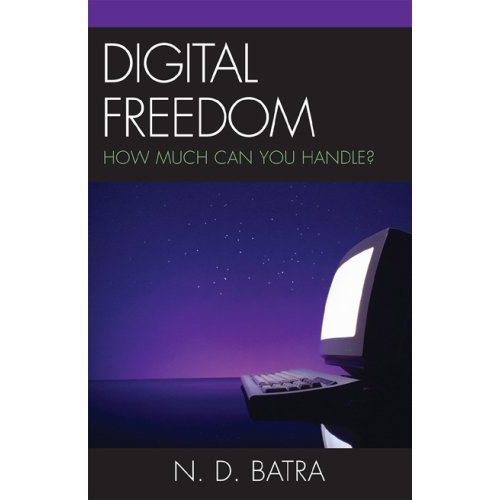Shamelessness or transparency?
From The Statesman
ND Batra
Last week a flamboyant student Andrew Meyer raised a ruckus at a meeting held at the University of Florida by Senator John Kerry, who in 2004 lost the presidential election to George W Bush. During the question answer time, Meyer in a length tirade accused Senator Kerry of being a wimp for not challenging the results of the election.
“There are multiple reports of disenfranchisement among black voters on the day of the election in 2004. There was also voting machines, electronic voting machines in Volusia County Florida that counted backwards… Didn’t you want to be president?”
The campus police took the unusual step of using electronic stun gun to subdue Meyer, who went on shouting, What have I done, what have I done, let me go… Soon the video was YouTubed and has been seen millions of time.
The world is becoming a digital theater, a place of grand and cruel and some time comic gestures in cyberspace. A well-rehearsed and structured tableau of victims and perpetrators in action, for example, could be uploaded for instant global spontaneous reactions, of curses and condemnations, of revenge and retributions. Anyone who wants to make an impact would develop a digital strategy to be on the centre-stage.
Terrorists digitise gruesome killing and let loose the images in cyberspace. In 2004 American television withheld from the public how the 26-year-old American telecommunications contractor Nicholas Berg’s head was chopped off in one fell swoop. But sooner or later those who loved the macabre and heinous surfed the net and discovered on their own the digitisation of terror. And millions did, as if it were another reality show.
In times like these when we are deluged with unceasing barrage of commentaries from talking heads and pundits, digitally capsulated significant moments tell the real story with telling effects. Whether you hear the click or not, somewhere a cell camera might have taken a snap of the moment that might become a witness to an atrocity or crime; but before the image finds its way to an inquiry commission or a court, the public would have the chance to see it in cyberspace, where court gag orders don’t always work.
Shortly after the picture of the abuse of Iraqi prisoners by the US troops were published in 2004, the Daily Mirror, a London tabloid, published photos of Iraqi prisoners being abused by British soldiers, which subsequently turned out to be fake. Instead of verifying the accuracy of the pictures in the light of mounting public criticism, as a responsible editor should have done, the Mirror’s editor insisted that the pictures were genuine and the newspaper’s account of the abuse was accurate. Though the editor lost his job for publishing fakery, there’s a lesson to be learned that in the Internet age the responsibilities of media gatekeepers, anchorpersons and editors, have become all the more crucial. Sometimes the camera blinks and lies: digital distortion and manipulation is easy. By the time the Daily Mirror realized its error the damage had been done. Apologies cannot erase digital memories.
Databases exist in perpetuity. In the pre-digital era too faking photo was not difficult but now cut-and-paste can be done with a few clicks and uploaded for the world to see. Imagine if that had been done during the Nazi concentration camps, Holocaust might have been a different story. The Vietnam War is enshrined in two images: A little Vietnamese girl running scared and stark naked on a highway after a napalm bomb attack; and the other, a Viet Cong prisoner being shot point blank. If instead of a digital camera, which has no negative and needs no development, an analogue camera had been used at Abu Ghraib prison, someone probably would have stopped the picture development for fear of exposure. The words wouldn’t have captured the sexual humiliation and degradation of Iraqi prisoners whose only fault was that they were captured and wouldn’t respond to military intelligence experts’ extreme interrogations. Torture of prisoners of war and others has been an ignored but universal practice, regardless of Geneva Conventions, but now that unobtrusive cell cameras can not only capture the outrage but instantly put it on into cyberspace, thanks to wireless satellite uplinks within the reach of most of us, transparency and instantaneity have become a modern condition and a diplomatic hazard.
When Abu Ghraib prison atrocities were uncovered, some practitioners of dark humor said that the torture chambers of Saddam Hussein were under a new management, the United States Management, and it’s business as usual. The liberators have become torturers, instead of spreaders of democracy in the Middle East. Probably this kind of reaction was uncalled for and excessively vituperative, but you might say, what better way to tell that Americans had lost their way in Iraq.
Republican diehards were shocked that someone allowed those sadomasochistic pictures of prisoners to be shot at all. And worst still, they bemoaned why no one ever stopped them from finding their way into the media. They forget that in the digital age, it is impossible to stop information or images from being shared.
The Internet is a shareable, collaborative and un-censorable medium. Whatever can be digitised will find its way on the Internet, where brazen shamelessness, some call it transparency, is the norm.
(ND Batra, professor of communications and diplomacy at Norwich University, is the author of Digital Freedom. He is working on a new book: This is the American Way.)
Tuesday, September 25, 2007
Living Digitally
at Tuesday, September 25, 2007 Posted by Narain D. Batra
Topics
Culture,
Technology
![]()
Subscribe to:
Post Comments (Atom)

No comments:
Post a Comment